About Author: Shauheen Etminan is the founder of VCENNA, a biotech company specializing in natural drug discovery and development for mental health. He is a repeat founder, scientist, researcher, and product developer dedicated to integrating ancient Eastern knowledge in medicine and mysticism into modern science to develop more holistic wellness solutions for today. Shauheen holds a Ph.D. in Chemical Engineering and co-founded Magi Ancestral Supplements.
Imagine a realm where the boundaries of waking reality blur into the vivid landscapes of a dreamlike state. This is the domain of the oneirogens, the lesser-known cousins in the hallucinogen family, bridging our conscious minds with the unconscious through the enigmatic world of wakeful dreaming.
Psychedelics, known mostly for their serotonergic activity in our brains, induce profound alterations in perception, emotion, and thoughts. Yet, there’s a hidden chapter in this psychedelic saga – oneirogens [1], substances that our ancestors used to open our awareness into gateways for creativity, self-exploration, and mystical experiences through dreams and dreamlike states. These states of consciousness were sought, accessed, and explored by visionaries and seekers, from Eastern prophets and mystics like Zarathustra [2] and Rumi [3] to Western inventors, scientists, writers, and artists like Thomas Edison, Dmitri Mendeleev [4], Charles Dickens [5] and Salvador Dali.
In you, a portal lies unseen, seek not doors in the worldly sphere,
Each night, through this hidden gate, your spirit departs clear.
Yet as you roam, a dream’s soft cord entwines around your feet,
At dawn’s first light, it guides you home, your earthly self to greet.
Rumi (Sonnet 2450, Book of Shams)
The Psychedelic Phenomenon
The term “psychedelic” grabbed my attention for the first time at Burning Man 2014, when a passionate artist presented the theme of unearthly and vivid imagery in his work. Then, at TEDx BlackRockCity in the same year, I was exposed to two more talks and was able to discern between the term psychedelic as an adjective and perceptual experience and the term psychedelics as it commonly refers to psychedelic substances.
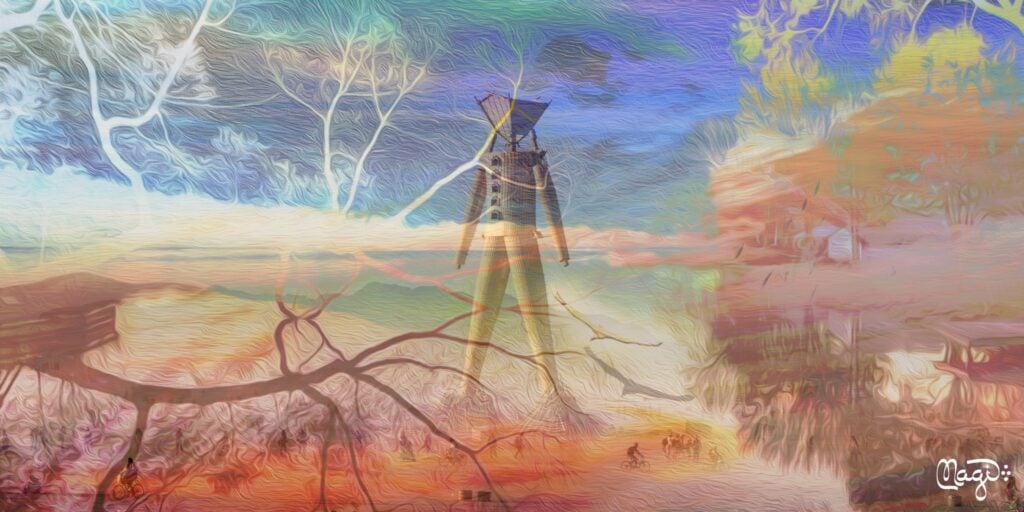
Psychedelics, a subclass of hallucinogenic drugs, primarily affect serotonergic receptors, triggering altered states of consciousness. Known as classic psychedelics, they cause specific psychological and sensory changes and, depending on the ingested doses, could substantially contribute to altering consciousness. Compounds like psilocybin, DMT, mescaline, and LSD are classic examples. Despite the clinical studies highlighting their psychotherapeutic applications, they remain largely illegal.
Psychedelics are gaining traction again due to the recognition of their traditional use, evidence of therapeutic capacities, and results from early-stage clinical research. This resurgence offers a chance to reconsider the criminalization of these substances and the broader war on psychedelics. On a more personal and subjective level, it’s fair to say that psychedelics are receiving traction for two reasons:
- Their altered experience fulfills our curiosity about our “self” and the broader consciousness (I call this the “mind-amusing” part).
- When taken thoughtfully and therapeutically, based on protocols, their results can be rewarding and immense.
Psychedelic Non-Psychedelics
Psychedelics fall under psychoactive hallucinogens, alongside dissociatives and deliriants. Dissociatives, like ketamine and nitrous oxide, produce a sense of detachment from the environment by blocking glutamate binding to NMDA receptors. Salvinorin A (Salvia) [6] is an atypical dissociative with a different mechanism.
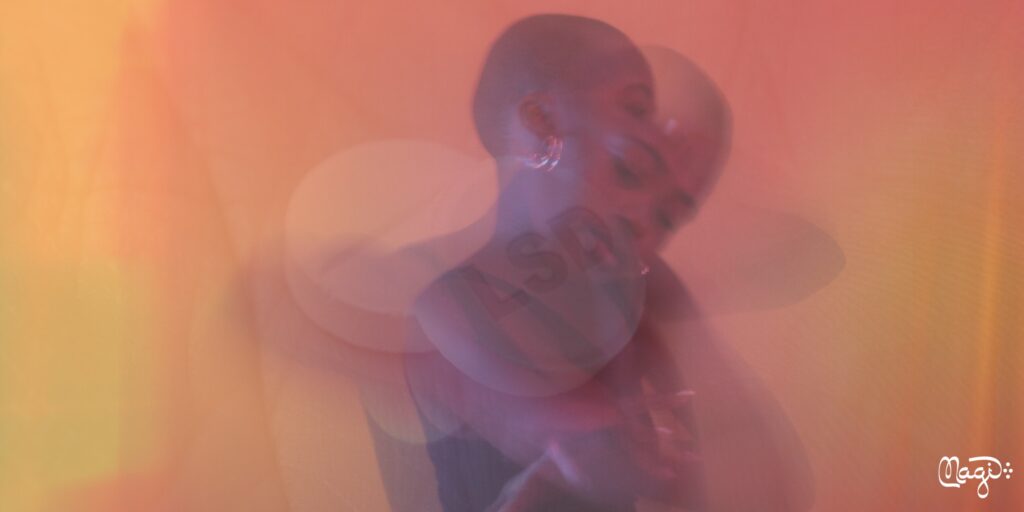
Unlike the lucid states that psychedelics and dissociatives may create, deliriants are known to create confusion, disorientation, delirium, and inability to control one’s actions. They tend to cause extremely realistic and often disturbing hallucinations that are difficult to distinguish from reality. Classical deliriants are anticholinergic, i.e. they block muscarinic acetylcholine receptors. Plants under the family Solanaceae, like Black Henbane, Datura, Mandragora, and Belladonna, all have tropane alkaloids [7] like atropine, scopolamine, and hyoscyamine. People who are curious about deliriants usually do not subscribe to a pleasant experience. Nevertheless, tropane alkaloids have been part of shamanic rituals and ancestral use for millennia, and there is strong evidence of their use in multiple traditions worldwide.
While in most of the psychoactive drugs study categorizations, psychedelics, dissociative, and deliriants are counted as different types of hallucinations, there is another lesser-known category of hallucinogens whose experience is not like any of the other three, and they are oneirogens.
Dream as A Psychedelic Experience
“The dream is a little hidden door in the innermost and most secret recesses of the soul.”
Carl. G. Jung
Dreams are our inner being communicating in the ancient language of images and symbols [3]. Dreaming is akin to a psychedelic experience and our gateway to expanded states of consciousness. However, we are usually not consciously present in our dreams and often entirely forget them upon waking. Accessing techniques to be awake and aware while dreaming opens our conscious mind to broader consciousness and has been an established practice among mystical and shamanic traditions.
Hidden aspects of our subconscious speak to us in dreams, and that’s why pioneering psychoanalysts like Sigmund Freud and Carl G. Jung paid particular attention to dreams to uncover the aspects of our self that are hard to catch and discover [8]. Working with our dreams opens communication channels, allowing our unconscious to reveal more about our inner self.
Many dreams are just “mind dreams” in which the mind works over its impression. Psychological dreams, though, have a different quality because they try to communicate something to our conscious self. Unlike mind dreams, psychological dreams leave us with an emotional residue or quality of feeling, and we need to work on these dreams to, as Jung says, “make them a living experience”. Psychological dreams shift our conscious awareness to a higher level if remembered and understood. Therefore, techniques to work with these dreams are key to self-discovery and consciousness expansion.
The first step to receiving insights from dreams is to remember them! Journaling dreams is one practice that helps us collect messages from our subconscious. Psychoanalysts ask their clients to immediately write their dreams down after waking up and help them unravel the messages lying in a single or series of dreams. The language of dreams is best not learned from books but from being with our dreams and becoming familiar with their subtleties and ways of speaking. Dr. Katherine Lawson, a California-based dream and psychedelics integration psychotherapist, adds it is possible to “seed” dreams or to dream intentionally using ancient techniques for dream incubation. The resulting dreams, when analyzed properly, can be a direct response to our queries.
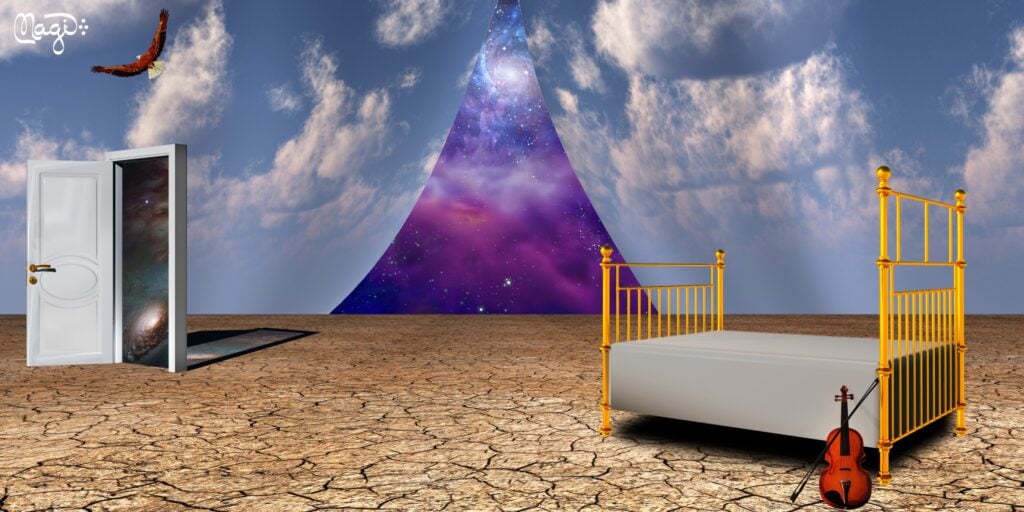
The other technique is to gain conscious awareness while we dream. This experience may occur randomly, accessed by certain contemplative practices (meditation, sensory deprivation, chanting, etc), or achieved through plant medicines in different states, i.e. while full in the dream, in a transitory dreamlike state between sleep and wakefulness (hypnagogia), or while dreaming awake. The transitory or liminal states are also known as hypnogogic states or “pre-oneirophrenic” states and are distinguished from full-in-dream experiences [1].
Dreamlike States and Oneirogens
Dreamlike states refer to various conditions where individuals experience sensations, perceptions, or hallucinations similar to those encountered in dreams, albeit while awake or in a semi-conscious state. Dreamlike states are often fluid and illogical, resembling the non-linear, surreal, and frequently symbolic narratives of dreams.
Substances that induce dreams or enhance dreamlike states of consciousness are called oneirogens. In Greek, óneiros means dream, and -gen means creating. According to Jonathan Ott, an oneirogen stimulates dream or hypnogogic phenomena in superficial stages of sleep, where hypnogogic refers to drowsiness, or preceding sleep, or reality, light stage of sleep [1].
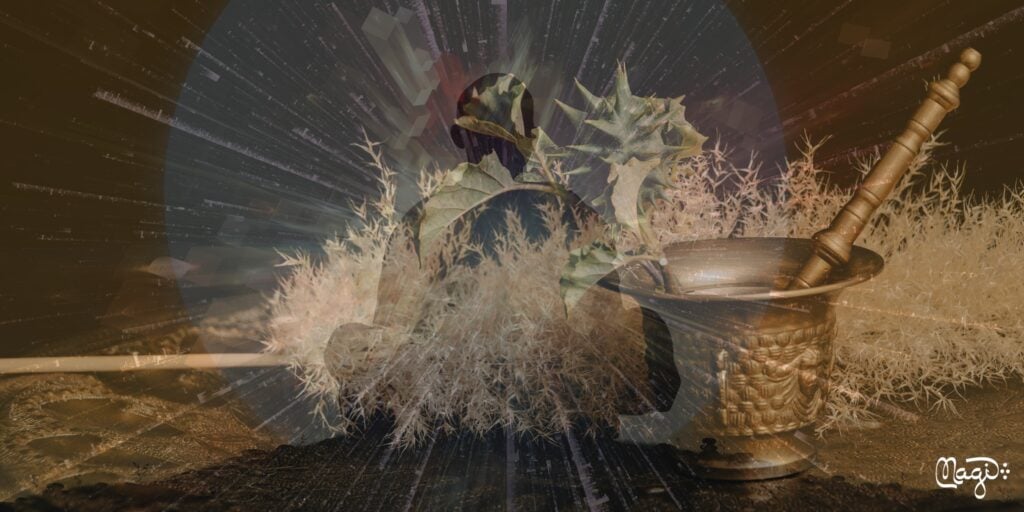
Dreamlike states are subjective and need discernment and rigor to meet those contributing to meaningful psychological, emotional, and spiritual insights and epiphanies. There are dreamlike states that induce confusing hallucinations or may lead to false realizations and perceptions. Most of the deliriants and some psychedelics can contribute to these states [9]. Naranjo (1973) [10] and Doss et al. (2023) [11,12] showed that most serotonergic psychedelics (Psilocybin, LSD, DMT, mescaline – including MDMA as an empathogen) induce false memory formation and retrieval, or typical interferences in thinking. They also increase suggestibility and familiarity that provide an emotional feeling of belonging and connection but may not necessarily contribute to insights underlying clarity and value. So, the question is, which dreamlike states are ideal for psychoemotional breakthroughs?
Which Dreamlike States?
The answer is those dreamlike states in which we have a sense of lucid presence, active awareness, and vigilant conscience while we dream [9]. It means that during the dream or in the dreamy state, we fully or partially possess our higher cognitive reasoning, critical faculties, rational mind, and intellectual abilities [15]. This liminal state and lucid experience have a quality of spontaneous emergence into consciousness [16].
Phenomenologists like Shutz and Bergson [2] believe that consciousness constantly shifts between infinite planes, constituting its mode of reality. In these liminal dreamy states, a transition from dreamless sleep to a dream state, there is always an interruption in the flow of consciousness. A dreamlike state brackets out the world, including the awareness of the body (i.e. the environment), replacing them with the dream body, dream perception, and an imaginal and/or symbolic world. At the same time, we are consciously aware, and process and this culminates in consciousness leaps in our awareness, i.e. experiences like revelations or epiphanies.
Some practices that induce dreamlike states with an experience of active awareness are:
- Lucid dreaming (asleep)
- Micronaps (transition)
- Hypnogogia/Hypnopompia (transition)
- Sleep deprivation (transition)
- Sensory deprivation (transition)
- Deep meditation (awake)
- Plant medicines (awake)
- Chanting/Dhikr (awake)
- Breathwork (awake)
- Whirling meditation (awake)
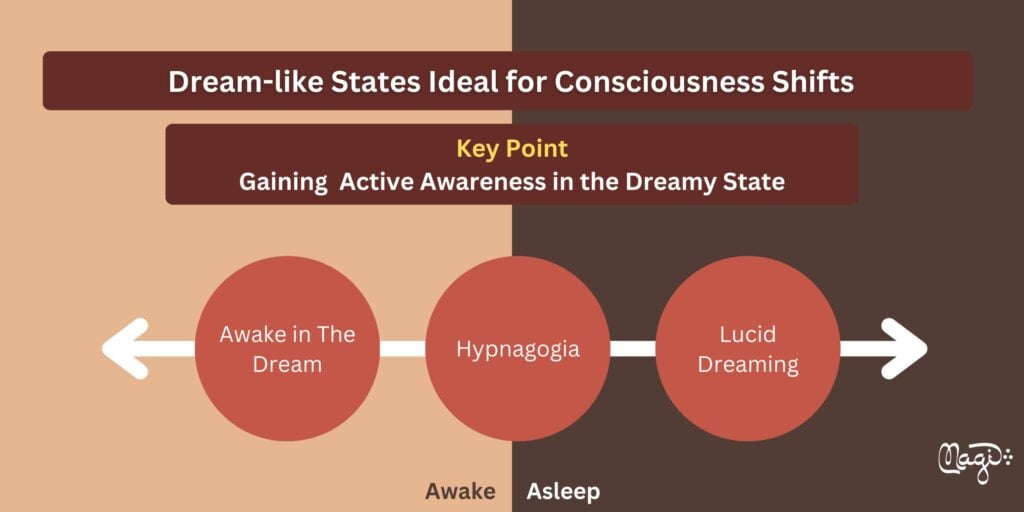
Ancient wisdom traditions have mastered techniques to induce hypnagogic or ecstatic dreamlike states for psychospiritual openings and to access the mystical realms. Western inventors, writers and artists also induced these states for creativity and problem-solving. In Part II of this article, we will review some of these states and elaborate on beta-carbolines subjective effects as pre-oneirogens.
References
- Toro, Gianluca, and Benjamin Thomas. Drugs of the dreaming: Oneirogens: Salvia divinorum and other dream-enhancing plants. Simon and Schuster, 2007.
- Louchakova-Schwartz, Olga. “Intersubjectivity and multiple realities in Zarathushtra’s Gathas.” Open Theology 4, no. 1 (2018): 471-488.
- Vaughan-Lee, Llewellyn. Sufism: The transformation of the heart. The Golden Sufi Center, 1995.
- Strathern, Paul. Mendeleyev’s dream: the quest for the elements. Macmillan, 2001.
- da Mota Gomes, Marleide, and Antonio E. Nardi. “Charles Dickens’ hypnagogia, dreams, and creativity.” Frontiers in Psychology 12 (2021): 700882.
- Doss, Manoj K., Darrick G. May, Matthew W. Johnson, John M. Clifton, Sidnee L. Hedrick, Thomas E. Prisinzano, Roland R. Griffiths, and Frederick S. Barrett. “The acute effects of the atypical dissociative hallucinogen salvinorin A on functional connectivity in the human brain.” Scientific Reports 10, no. 1 (2020): 16392.
- Kohnen-Johannsen, Kathrin Laura, and Oliver Kayser. “Tropane alkaloids: chemistry, pharmacology, biosynthesis and production.” Molecules 24, no. 4 (2019): 796.
- Snowden, Ruth. Jung: The Key Ideas: From analytical psychology and dreams to the collective unconscious and more. Hachette UK, 2010.
- González, Joaquín, José P. Prieto, Paola Rodríguez, Matías Cavelli, Luciana Benedetto, Alejandra Mondino, Mariana Pazos et al. “Ibogaine acute administration in rats promotes wakefulness, long-lasting REM sleep suppression, and a distinctive motor profile.” Frontiers in Pharmacology 9 (2018): 374.
- Naranjo, C. “The Healing Journey: Pioneering Approaches to Psychedelic Therapy.” Santa Cruz, CA: Multidisciplinary Association for Psychedelic Studies (MAPS).(Original work published 1973 by Pantheon Books, New York, under the title The Healing Journey: New Approaches to Consciousness.) (1973).
- Doss, Manoj K., Jason Samaha, Frederick S. Barrett, Roland R. Griffiths, Harriet de Wit, David A. Gallo, and Joshua D. Koen. “Unique effects of sedatives, dissociatives, psychedelics, stimulants, and cannabinoids on episodic memory: A review and reanalysis of acute drug effects on recollection, familiarity, and metamemory.” Psychological Review (2023).
- Doss, Manoj K., Loft, K, Mason, N. L., Mallaroni, P., Reckweg, J.T., Oorsouw, K.V, Tupper, N., Otgaar, H., Ramaekers, J. G. “Ayahuasca Enhances the Formation of Recollection-Based Memory in Experienced Ayahuasca Users.” Under Review (2023)
- Dumpert, Jennifer. Liminal Dreaming: Exploring Consciousness at the Edges of Sleep. North Atlantic Books, 2019.
- Waters, Flavie, Jan Dirk Blom, Thien Thanh Dang-Vu, Allan J. Cheyne, Ben Alderson-Day, Peter Woodruff, and Daniel Collerton. “What is the link between hallucinations, dreams, and hypnagogic–hypnopompic experiences?.” Schizophrenia Bulletin 42, no. 5 (2016): 1098-1109.
- Brown, David Jay. Dreaming Wide Awake: Lucid dreaming, shamanic healing, and psychedelics. Simon and Schuster, 2016.
- Ghibellini, Romain, and Beat Meier. “The hypnagogic state: A brief update.” Journal of sleep research 32, no. 1 (2023): e13719.


